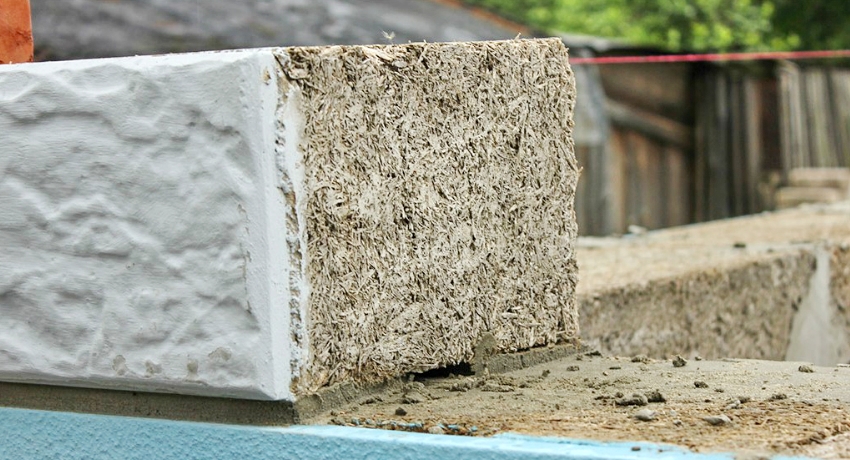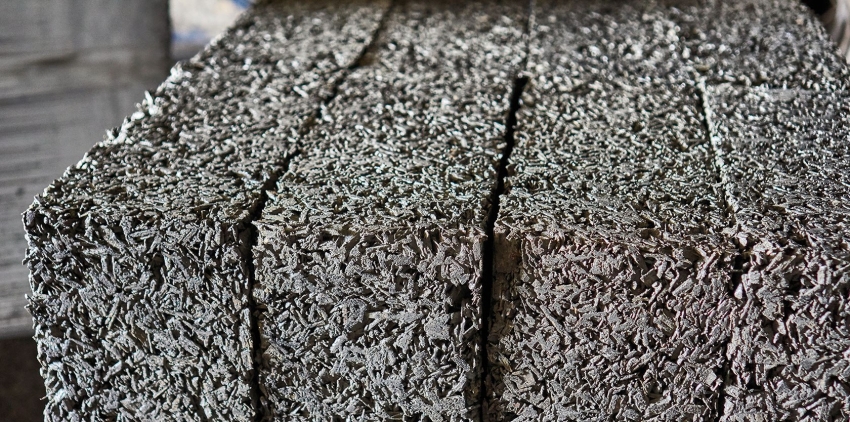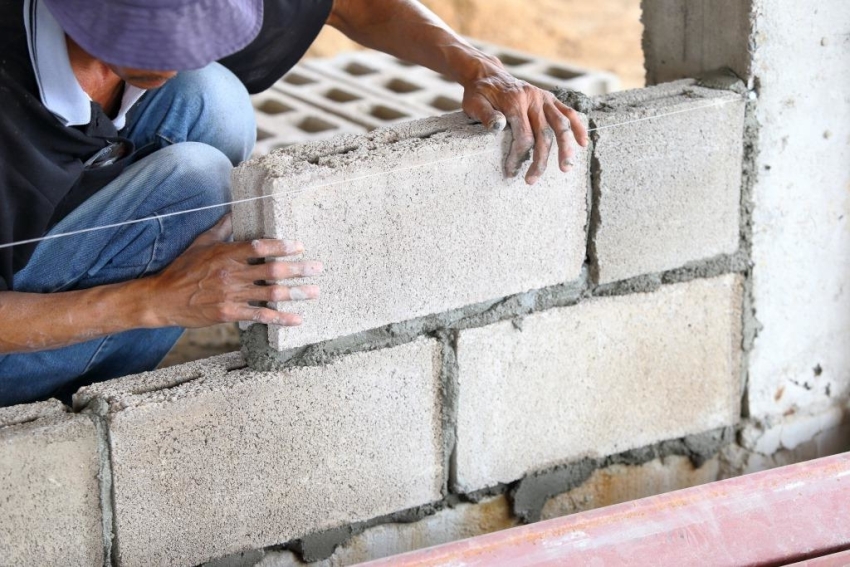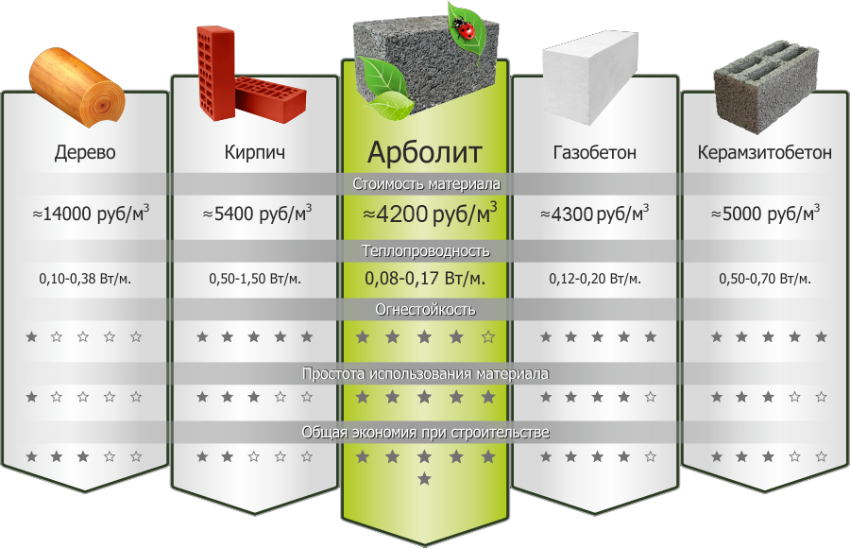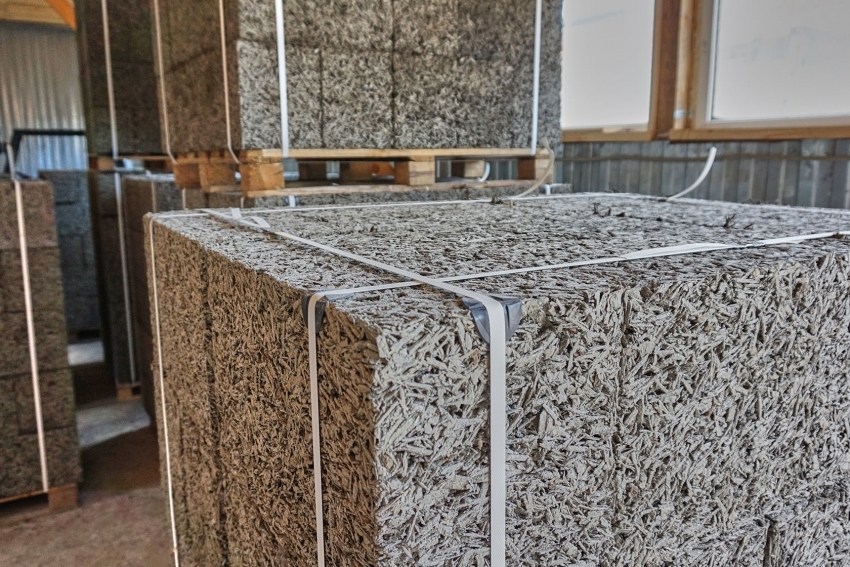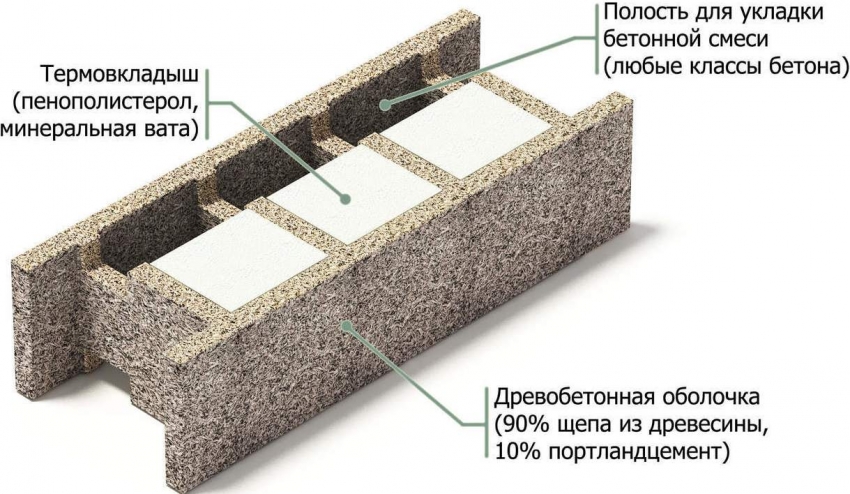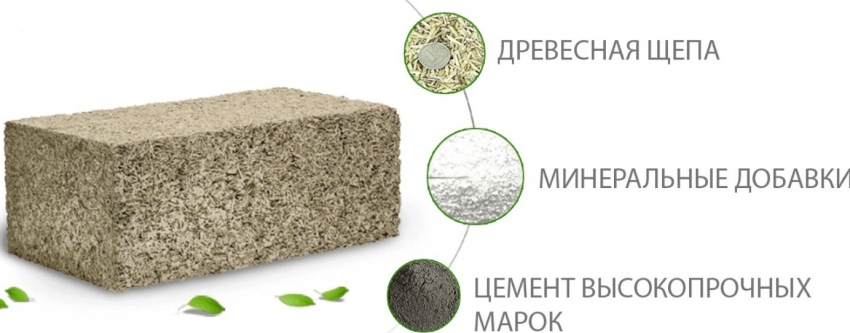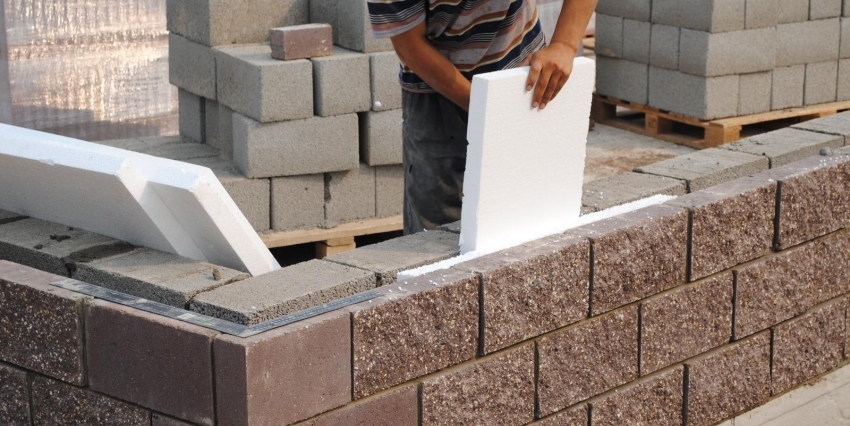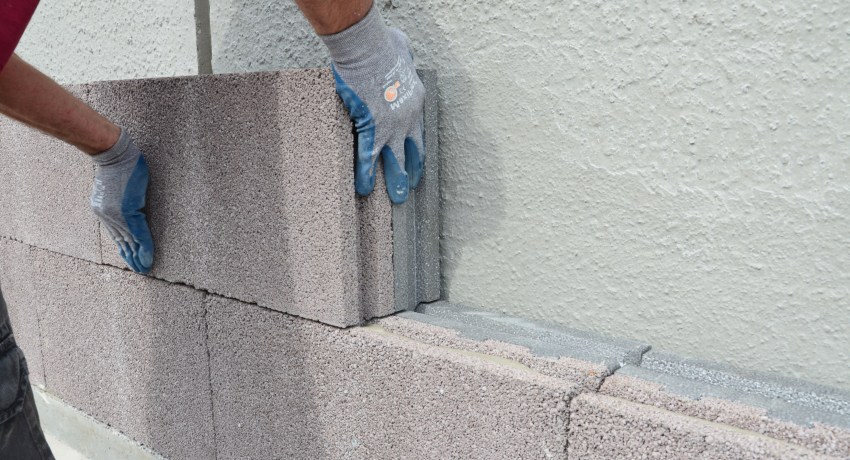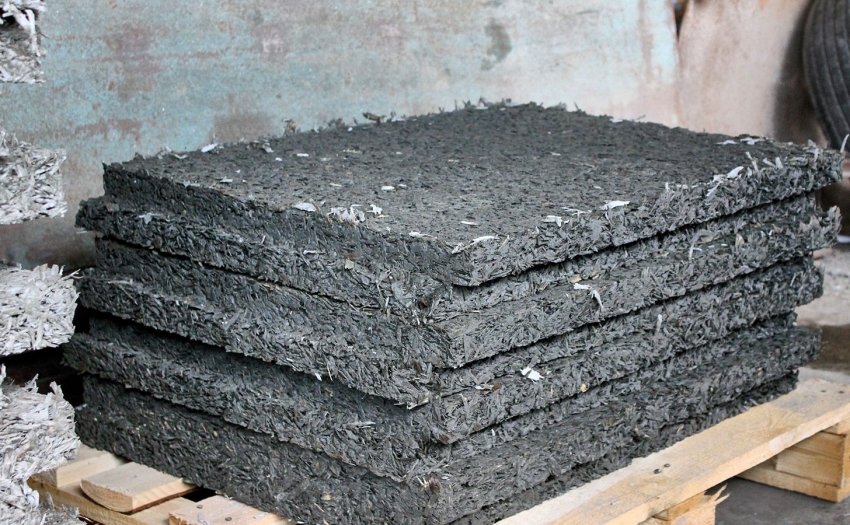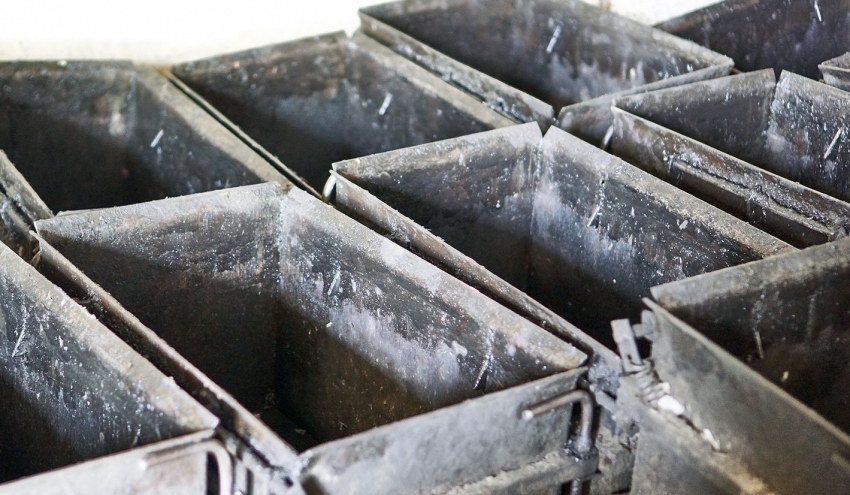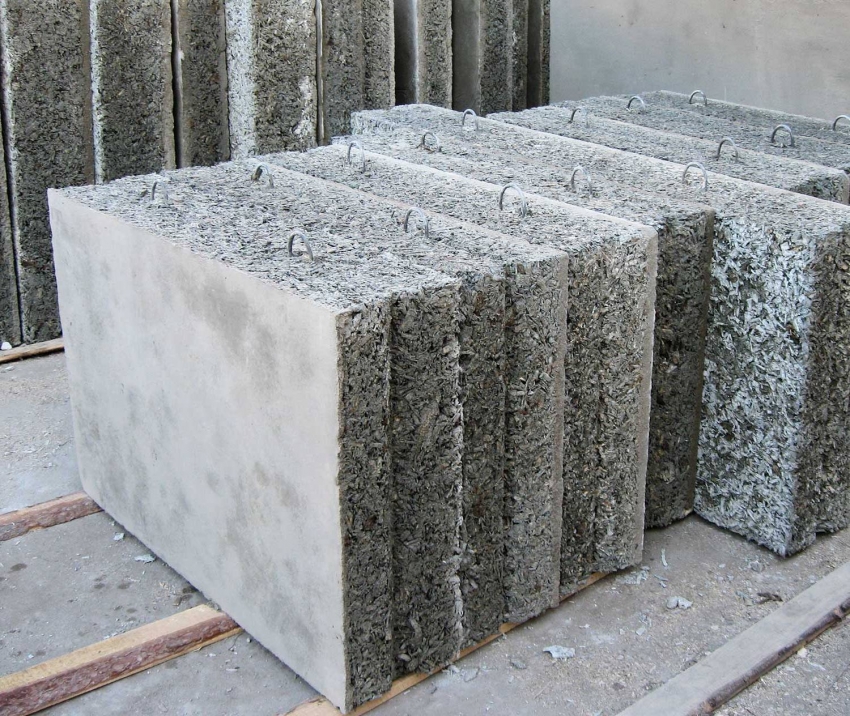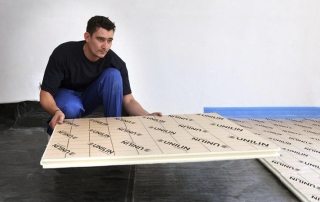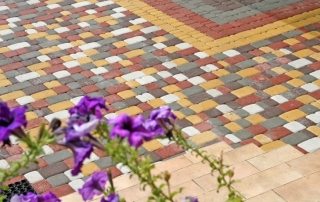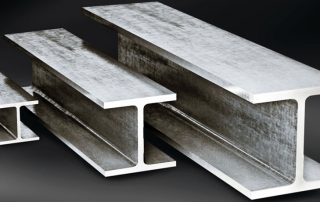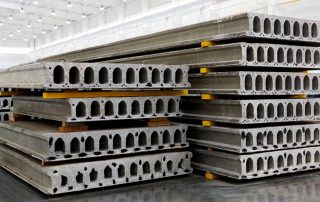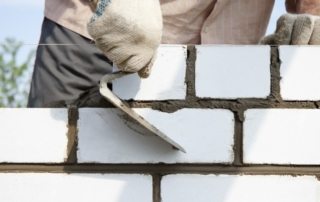One of the features of the modern approach to low-rise construction is the use of materials with simple installation technology and a minimum heat transfer coefficient. Arbolite blocks: the price of which is affordable for all Russians, fully meet these requirements. Suffice it to say that this building material is many times superior to brick, cinder blocks and concrete in terms of heat transfer coefficient, and wood is inferior only slightly.
Content
- 1 What is wood concrete and its main properties
- 2 Comparison of the characteristics of wood concrete blocks with other building materials
- 3 Arbolite blocks, price per piece of the most demanded types
- 4 Features of the composition of wood concrete blocks
- 5 Sizes of wood concrete slabs
- 6 Making wood concrete blocks with your own hands
- 7 Which is better: wood concrete or aerated concrete
- 8 Some features of the construction of a bath from wood concrete
- 9 Arbolite blocks: reviews of home owners, cons
What is wood concrete and its main properties
First of all, consider the composition of wood concrete. It is based on dried sawdust. At the same time, certain requirements are imposed on wood chips for wood concrete. Its particles should have a needle-like shape and fit into the following sizes:
- width from 10 to 12 mm;
- thickness from 2 to 3 mm;
- length - not less than 15 and not more than 25 mm.
Chips are mixed with cement binders and other additives that improve the quality of the final product - wood concrete blocks. Immediately after the preparation of wood concrete (as professionals call the resulting mixture), it is poured into molds and compacted using a vibrating table. After 30-40 hours at the next stage of the production of wood concrete building material, these blocks are removed from the molds and placed on a special site, where they gain strength. This will take up to 30 days. And only then this building material can be used.
Useful advice!When creating wood concrete with your own hands in the form of blocks, lay them in a wet state under the film. The hydration process at a temperature of 15 ° C for 10 days will give them the maximum possible strength.
This technology makes it possible to create wood concrete blocks of different sizes. They can be both wall and partition walls. As for the specific size of a building block of this type, modern industry adheres to the following characteristics in the production:
- height from 20 to 25 cm;
- width from 5 to 25 cm;
- length no more than 60 cm.
In addition, additional products are also produced.Based on the name, it becomes clear that such wood concrete blocks, which have the shape of corners, halves and other "irregular" geometry, make it possible to do without adjusting and trimming ordinary elements. Thanks to this technical solution, the buyer can choose the wood-concrete building material of the most suitable configuration.
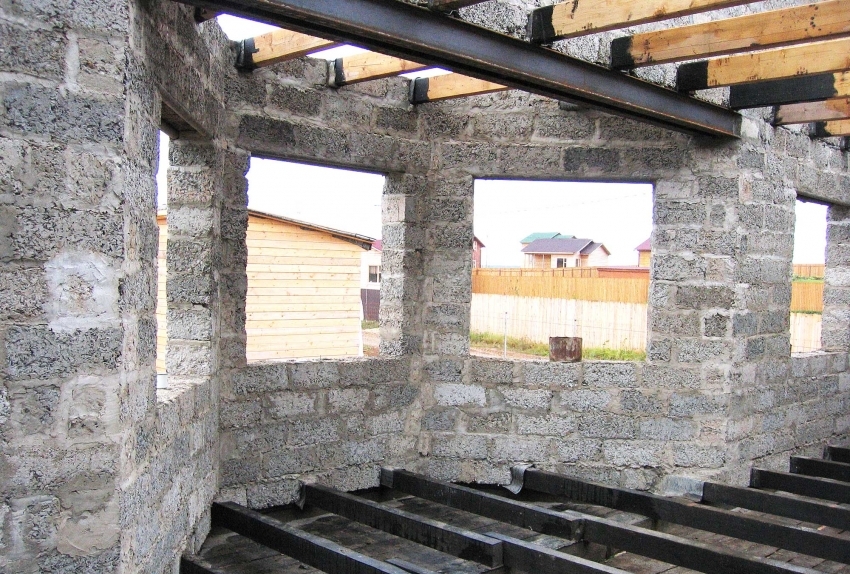
With the help of wood concrete blocks, you can quickly build walls for the house, since a minimum amount of time is needed for shrinkage
Let's focus on the thermal conductivity of wood concrete. It is useful to know for people seeking to save as much as possible on the construction of a country cottage. The wall of a house made of wood concrete blocks with a thickness of 20 cm corresponds in terms of the heat transfer coefficient to a brick wall of 1 meter thickness. Therefore, in the cold regions of our country, the cost of building insulation will be noticeably less compared to using bricks.
Another significant advantage of sawdust and cement blocks is their low weight. After all, they are 80-90% composed of dried chips. For this reason, the bearing capacity of the foundation can be approximately the same as for a wooden structure.
Comparison of the characteristics of wood concrete blocks with other building materials
In order to understand whether wood concrete blocks are suitable for construction, it is worth making a comparative analysis of the properties of the most popular building materials.
Comparison of the properties of wood concrete, timber, aerated concrete and brick:
| Material property | Brick | Cellular concrete | Wooden beams | Arbolit |
| The degree of difficulty of attaching a home structure to the wall | Special fasteners | Expensive special fasteners designed to handle fragile material | Perfectly fastened with screws, nails, ordinary dowels | Excellent fastening with screws, nails, ordinary dowels |
| Construction and commissioning period | A long and expensive process, since insulation and finishing are required | Rapid wall erection. A lot of time is spent on external insulation of the facade. This process is time consuming and expensive. | Due to the shrinkage of the material after a year after construction, finishing work will be required | Fast wall erection, add. no insulation is required, finishing can be done immediately |
| Foundation cost | Expensive, massive | Expensive massive monolithic strip foundation | Economical, lightweight | Lightweight, economical |
| Microclimate at home | The organization of forced ventilation of the room will be required | Weak breathing | Removes high humidity, breathes | Removes high humidity, breathes |
| Flexural strength | Fragile, does not work on bending | Deprived of plasticity, brittle, gives massive cracks during foundation vibrations, does not tolerate transportation | Works well for bending | It works well for bending, does not crack when the foundation vibrates, it tolerates transportation perfectly |
| Biostability | Biostable | Biostable | Rots | 5 group of biostability |
| Fire resistance | Non-combustible material | Non-combustible material | Flammable | Fire does not support |
| Thermal conductivity, Watt / (m × ° С) | 0,560-0,850 | 0,140-0,320 | 0,150 | 0,07-0,17 |
| Density, kg / m³ | 1150-1950 | 200-1200 | 450-600 | 400-850 |
The vapor permeability of wood concrete blocks is only slightly less than that of wood. Thanks to this property, the moisture level in houses made of wood concrete is always optimal. The strength of wood concrete blocks does not depend on the degree of absorption and evaporation of moisture, therefore, during its transfer, the walls are not destroyed.
Useful advice! When choosing products, pay attention to the sides of the products. If one of their ends is smooth, and all the others differ significantly from it, it is better to refuse to buy the proposed batch, since this sign indicates that the technology for the production of wood concrete was violated, and the cement simply fell down.
The quality of wood concrete is significantly influenced by the degree of sawdust drying.If only dry chips were used, then the value of the internal moisture content of the blocks will never become critical, therefore, the wall erected from them will not be afraid of frosts. When wet sawdust was used, it is possible that after a few winters the wood concrete will begin to lose strength. Indeed, at negative temperatures, the water will freeze, while increasing in volume, which, in turn, leads to the destruction of the binder component.
Other practical properties of this material are worth highlighting:
- tensile loads are not terrible;
- mold and rot resistance;
- not afraid of fire.
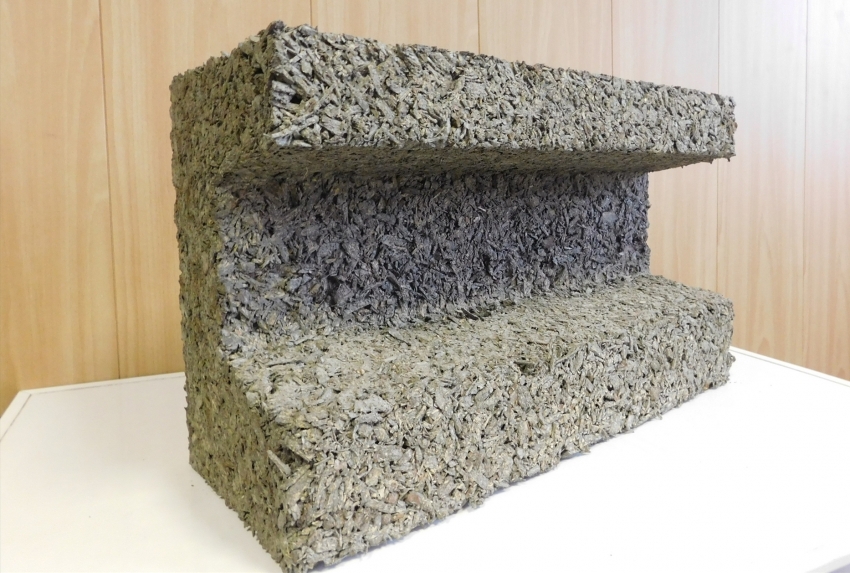
Arbolite blocks can have a variety of shapes, so that during construction, you can do without adjusting and cutting conventional elements
Due to the latter property, the degree of fire hazard of wood concrete houses is closer to this indicator of stone and brick buildings than wooden structures. However, if a large-scale fire occurs inside a building, or it ends up in a large fire zone, the walls will lose a significant part of their strength. Reinforced concrete, stone and brick are less prone to such consequences, which cannot be said about other types of lightweight concrete.
Arbolite blocks, price per piece of the most demanded types
Modern industry produces two types of wood concrete - structural and heat-insulating. The material of the second type is not used in the construction of external and internal walls, since it is characterized by a relatively low density and relatively low weight. It is successfully used for insulating buildings, residential buildings built of bricks, expanded clay concrete, and other building elements.
Structural type blocks are required to create load-bearing walls. Their strength and density indicators are higher than those of similar products from heat-insulating wood concrete.
Comparative characteristics of heat-insulating and structural wood concrete:
| Wood concrete type | Application in construction | Compressive strength class | Strength, kg / cubic meter | Density, kg / cubic meter |
| Heat insulating | Wall insulation | B 0.35-1.5 | M5, M10, M15 | 400-500 |
| Structural | Construction of load-bearing walls | B1.5-B3.5 | M25, M35, M50 | 500-700 |
The most popular types of these products include wood concrete blocks of the following types:
- large wood concrete products. They are used for masonry walls subject to stress. Sample sizes - 500 × 300 × 200 mm. You can buy wood concrete blocks of this type at a price of 120 rubles / piece. They are marked as follows: D500, D600;
- small wood concrete blocks. They are mainly used for laying insulating rows and for erecting non-load-bearing lightweight walls. Block size - 190 × 190 × 300 mm. Grades - D500, D600. As for the price of wood concrete blocks of this type, it fluctuates around the mark of 60 rubles / piece.
Arbolite blocks: price depending on the scope
The cost of the product in question is also influenced by what it is used for, as well as the configuration of a single product.
Useful advice! Buy wood concrete blocks, on the surface of which there is no white bloom. This is evidence of the addition of glue, which is not allowed by the technology.
Consider the data on brands of wood concrete products with an indicator of 600-650 kg / m³. The indicators presented in the table are approximate, since they may differ in different regions of the country.
The cost of different types of blocks and their characteristics:
| A type | Price for 1 cubic meter, rub. | Number of pieces in 1 cube | Approximate weight pcs / kg | Dimensions, mm |
| U-shaped block for with recess for armpole or window lintels | 4900 (148.48 per 1 piece) | 33 | 12 | 500×200×300 |
| Partition | 5100 | 53,3 | 11,5 | 150×250×500 |
| 5000 | 40 | 15 | 200×250×500 | |
| Stenovoi | 4300 | 26,6 | 22,5 | 300×250×500 |
| 4200 | 20 | 30 | 400×250×500 |
Features of the composition of wood concrete blocks
The main components of wood concrete are aggregates, chemical additives, mineral binders, water.
The function of organic additives is performed by:
- woodworking waste (pine, fir, poplar, spruce, aspen, beech, birch);
- waste from the processing of raw materials - flax or hemp fire;
- stalks of rice straw, cotton.
The most demanded filler is wood material, in particular, sawdust with shavings (1: 1, 1: 2), sawdust with shavings and chips (1: 1: 1), shavings, wood chips, shredded chips. The proportions of the filler indicated above in the arbolit are taken by volume, and not by weight. Usually, those who are engaged in the manufacture of building blocks with their own hands use a standard bucket as a unit of measure. For example, the proportion of wood concrete components 1: 2 means 2 buckets of shavings and one bucket of sawdust. Flax campfire or hemp stalks can be used in place of the last ingredient.
Placeholder requirements are formulated as follows:
- the concentration of bark impurities in the crushed raw materials should not exceed 5% needles and 10% leaves;
- particles should not be too small. Otherwise, more cement consumption will be required.
The main drawback of the material is its chemical activity.
Note! When preparing the batch, the use of larch and freshly cut wood of all species without exception is not allowed.
Flax fire is a full-fledged filler, but only if the following technological requirements are met:
- particle length no more than 40 mm;
- the obligatory introduction of chemical additives due to the presence of sugars in the composition;
- in order to improve the quality of wood concrete, the technological process includes a procedure for processing the material with milk of lime (50 kg of lime per 200 kg of this aggregate);
- after processing, before adding to the batch, the fire is kept for up to 2 days.
Related article:
Which blocks are best for building a house: an overview of various materials
Classification, constituent materials, technological parameters and dimensions. Distinctive characteristics, price-quality ratio.
This technology allows reducing the consumption of Portland cement to 100 kg per 1 cubic meter of wood concrete. And there is one more requirement: there should be no signs of mold and rot, foreign particles in the raw materials. If work on the manufacture of wood concrete blocks is carried out in the winter, it is necessary to control the presence of ice and snow in the aggregate. It is necessary to get rid of such inclusions at the stage of raw material preparation.
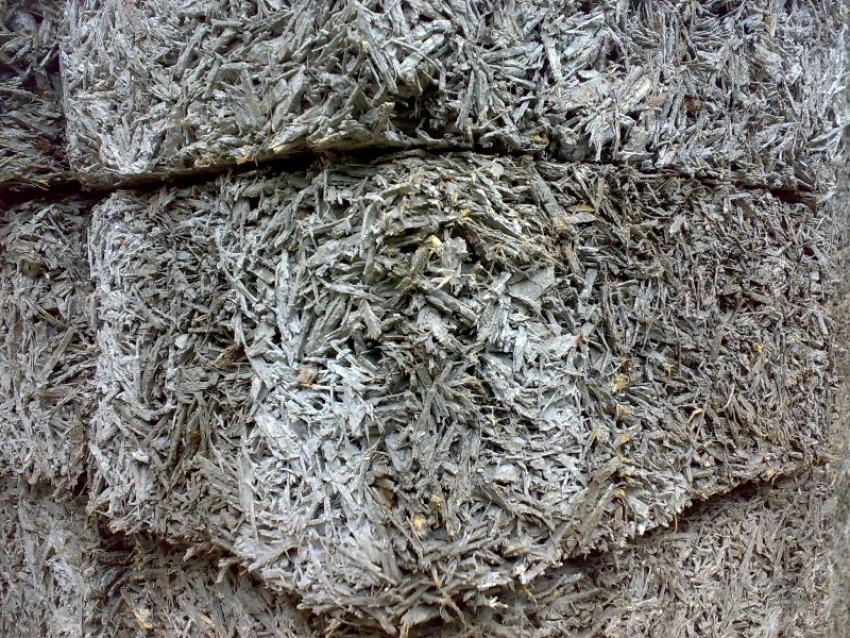
Despite the fact that wood concrete is made of wood chips, which have a high rate of moisture absorption, the blocks themselves are non-absorbent material.
Useful advice! Test the products when purchasing. Purchase only the batch from which you cannot pick out the chips with your hands. This is a sign of good adhesion.
Chemical additives are introduced to ensure the compliance of wood concrete with GOST and perform the following functions:
- accelerate hardening;
- regulate the degree of porosity;
- slow down corrosion;
- give the final product high bactericidal and insecticidal properties.
The use of additives is recommended regardless of the climatic zones of our country for which projects of houses from wood concrete blocks have been developed - from the Arctic to the subtropical. Among other things, special chemical additives provide an improvement in the quality of products due to the possibility of using aggregates without preliminary curing.
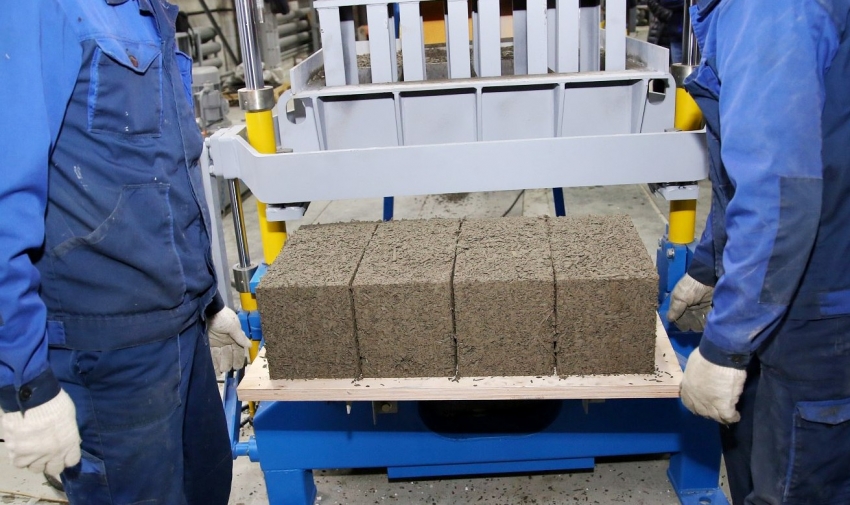
Wood concrete manufacturers assure that this is an environmentally friendly product, but when buying it is still worth asking for quality certificates
The following additives are used:
- aluminum sulfate;
- slaked lime;
- calcium chloride;
- liquid glass.
Calcium chloride and aluminum sulfate are considered to be optimal additives. The use of the latter compound allows to increase the strength of wood concrete.This is due to the fact that aluminum enters into a reaction with sugars and, by neutralizing them, transforms them into a harmless state.
The amount of additives in wood concrete blocks from the manufacturer does not usually exceed 2-4%. In absolute terms, this is about 12 kg per 1 cubic meter of wood concrete. Both options for the use of additives are allowed - in combination or separately.
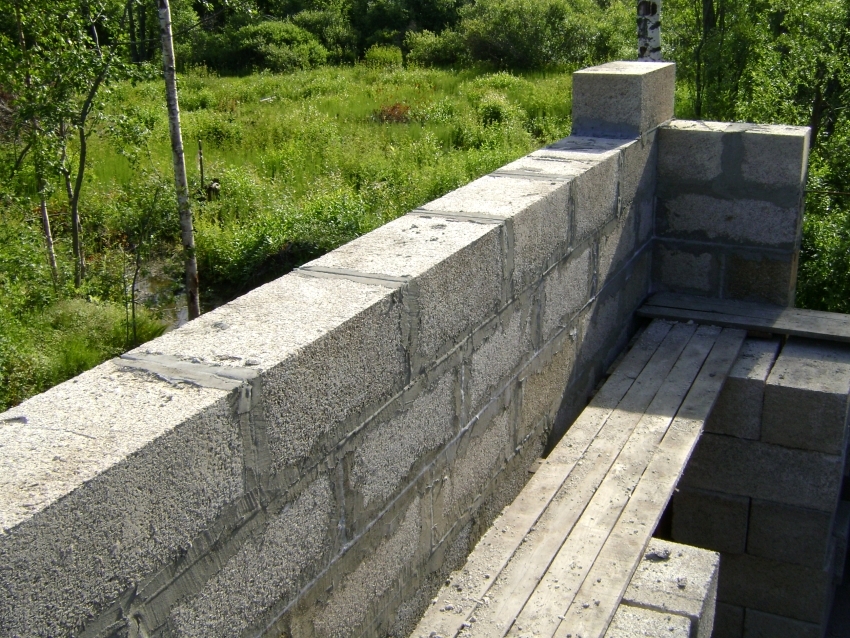
According to the reviews of the builders, it is possible to plaster the walls with wood concrete no earlier than two months after the construction
Their proportional ratio is determined by the required grade strength of wood concrete. So, for example, wood concrete grade M30 may contain the following combinations of additives:
- aluminum chloride (AlCl3) and calcium chloride (CaCl2) 4% by weight of used cement in a ratio of 1: 1;
- aluminum sulfate (Al2 (SO4) 3) and calcium chloride - the proportions are the same;
- sodium sulfate (Na2SO4) and aluminum chloride 2% by weight of cement, ratio 1: 1;
- aluminum chloride and sodium sulfate (Na2SO4) 4% of the total weight of cement in a 1: 1 ratio.
Sizes of wood concrete slabs
A distinctive feature of these products from wood concrete blocks is reflected in their name. The concept of "slab" means that the thickness of a unit of such products is noticeably less than its other dimensions - length and width.
For their production, recycled wood chips and cement are also used. The production of canvases is carried out by tamping and pressing. Compared to the process of production of slabs from all grades of lightweight concrete, the production of such products from wood concrete takes much less time (the duration of vibrocompression is only 20 seconds). In order for the products to gain brand strength, they are left for several days in a room with a strictly measured temperature regime.
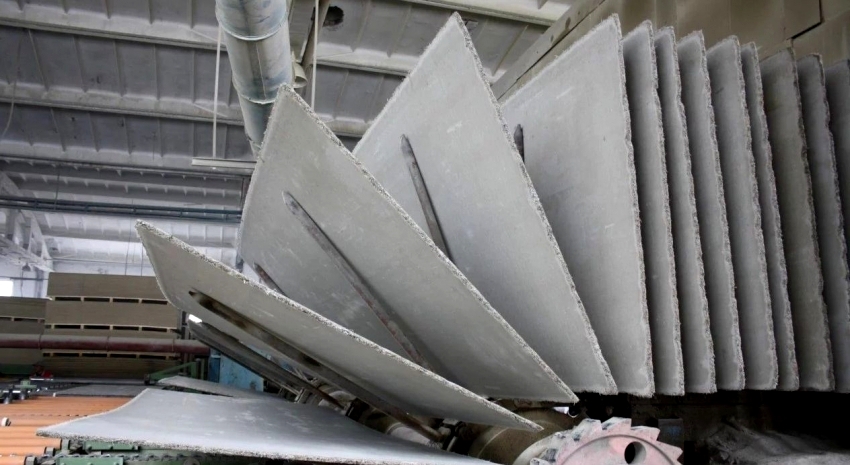
Arbolite plates are used for the construction of walls, window and door openings, for ordinary, upper and reinforced lintels
Useful advice! To ensure a long service life of wood concrete slabs, they need to be finished externally and internally as soon as possible.
Currently, wood concrete slabs are produced in the following sizes (unit of measurement - centimeters):
- wall sheet (these are the largest panels) - 28 × 118 × 229, 30/40 × 118 × 230;
- narrow canvases (products for upper lintels, extensions) - 28 × 58 × 229, 30/40 × 60 × 230;
- window panels - 28 × 58 × 81, 28 × 118 × 81 and 30/40 × 118 × 80;
- ordinary jumper blocks - 28 × 178 × 58;
- reinforced jumper blocks - 28 × 238 × 58.
During the production of external sheets equipped with fastening reinforcement loops, they are immediately covered with a “rough” facing layer. This layer consists of cement-sand plaster, and its thickness is 150 mm. This technical solution allows the customer to save on external finishing.
Making wood concrete blocks with your own hands
Making wood concrete at home attracts with the opportunity to purchase the necessary materials at a low price. But for this it will be necessary to organize a kind of mini-plant with different equipment for the production of wood concrete blocks. In principle, you don't have to buy the necessary devices, but rent them: although it is not easy to find them, it is possible thanks to the Internet.
We already know that wood concrete blocks are a building material, for the manufacture of which certain components must be used. Their list is indicated above, but we will consider the proportions later.
Proportions of ingredients in one cubic meter of wood concrete:
| Arbolite grade | Water, l | Chemical additives, kg | Organic filler, kg | Cement, kg |
| M25. Structural wood concrete | 350-400 | 12 | 240-300 | 300-330 |
| M15. Heat-insulating wood concrete | 350-400 | 12 | 240-300 | 250-280 |
In practice, when there are no appropriate measuring instruments at hand - scales and measuring containers - professionals recommend using the following formula: 1 cubic meter of wood concrete = 4 parts of water + 3 parts of wood chips +3 parts of cement. The amount of chemical additives remains the same - 12kg.To determine the desired weight, you will have to focus on the numbers on their packaging.
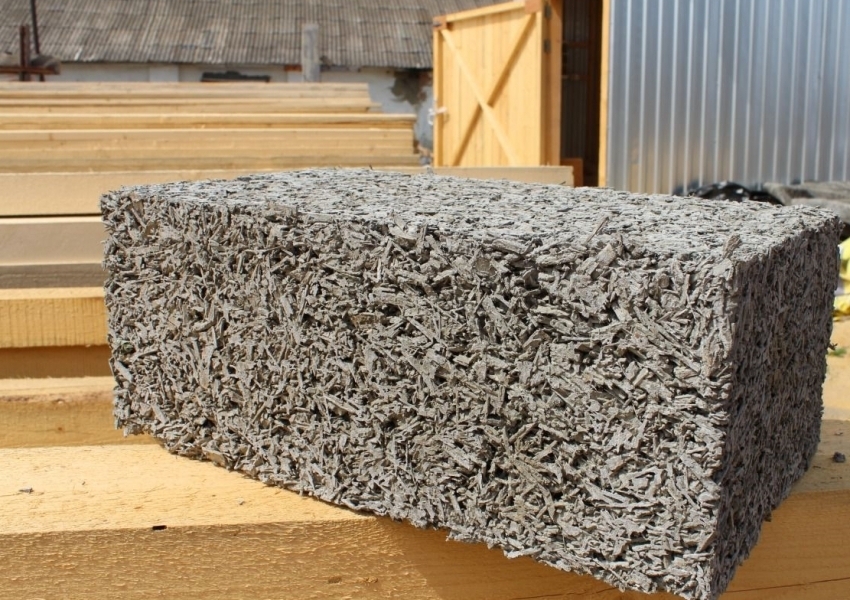
It is worth considering that the manufacture of wood concrete in the cold season is possible only at a stable round-the-clock indoor temperature not lower than + 12-15 ° С
What equipment and general manufacturing technique is needed
In the case when we are talking about the mass production of building materials of the type in question (for example, when building houses in a cottage village), it is impossible to do without a machine for the production of wood concrete blocks. On sale you can find samples of such equipment at a price of about 14 thousand rubles. with a capacity of up to 40 items per hour.
If it is planned to make wood concrete blocks to ensure the construction of one private house, it will be necessary to acquire the following devices:
- container for the mixture;
- vibrating sieve;
- trap for chips;
- giving table;
- shock-shaking table;
- form inserts;
- metal mold tray;
- detachable form;
- vibration shaping unit.
For the manufacture of the form, ordinary wooden boxes are used. From the inside, they are upholstered with linoleum. Arbolite is put into the mold in layers. This must be done in 2-3 passes. After laying, each layer is carefully compacted.
Useful advice! To remove excess air and moisture from the mass, pierce it with fittings. This will increase the strength of the final product.
The last layer is not smoothed, it is left uneven. It should not reach the edge of the sides by 2 cm. This space will be filled with plaster. It is recommended to keep the block in shape for at least 24 hours.
Which is better: wood concrete or aerated concrete
In order to answer this question, it is necessary to compare the properties of both materials.
Comparison of the properties of wood concrete and aerated concrete:
| Block parameters | Arbolit | Aerated concrete | Comments |
| Standard Features for Structural Walls | 200 × 300 × 500 (mm) | 250 × 375 × 625 (mm) | The walls of the house and wood blocks are colder because the thickness of the element is less |
| Dimensional error, +/- mm | 5 | 1 | The presence of unevenness on the surface of wood concrete blocks complicates the alignment of the walls, which, in turn, causes an increase in material consumption and the formation of "cold bridges" between the masonry seams |
| Fire resistance, hour | 0.75 to 1.5 | 3-7 | The wood block is less resistant to high temperatures |
| Shrinkage (mm per m) | 0,4-0,5 | 0,35-0,46 | Natural filler is characterized by a higher shrinkage rate |
| Elastic modulus, MPa | 250-2300 | From 1734 | Arbolite block withstands loads better |
| Water absorption,% | 40-85 | <15 | The absorption of moisture by the wood block is facilitated by the presence of a vegetable filler in its composition. Therefore, wood concrete requires reliable protection. |
| Thermal conductivity coefficient of dry blocks, W / m2 | 0,08-0,17 | 0,072-0,14 | Thermal insulation of aerated concrete is higher |
| Average density, kg / cubic meter | 500-850 | 300-600 | Arbolite blocks create a heavy load on the foundation |
| Frost resistance, cycle | 25-50 | 35-50 | Aerated concrete products have a longer service life |
There is also one more important criterion - the convenience of facing. Judging by the reviews, wood concrete blocks outperform aerated concrete products in this regard. They do not crumble under mechanical stress. Therefore, the panels can be fastened using conventional anchors.
Some features of the construction of a bath from wood concrete
The cost of building a bath from this material is the same as that of assembling a structure from a log or wooden bar. However, the use of wood concrete in the masonry of walls provides ample opportunities in planning and decoration both outside and inside. The inner lining can be made of a standard "bath" material - Euro lining or blockhouse.And the use of ceramic tiles allows you to create an interesting effect by introducing a color scheme corresponding to its functionality into the interior of the room. The exterior walls can be decorated in any way, from the usual blockhouse under a rounded beam to a log.
But in any case, it is necessary to take into account the hygroscopicity of wood concrete. That is, the walls of the bath must be carefully sheltered from moisture.
Useful advice! From the inside, the building should be sheathed with a vapor barrier, leaving free space between the interior decoration and the blocks. The outside can be plastered or overlaid with decorative bricks.
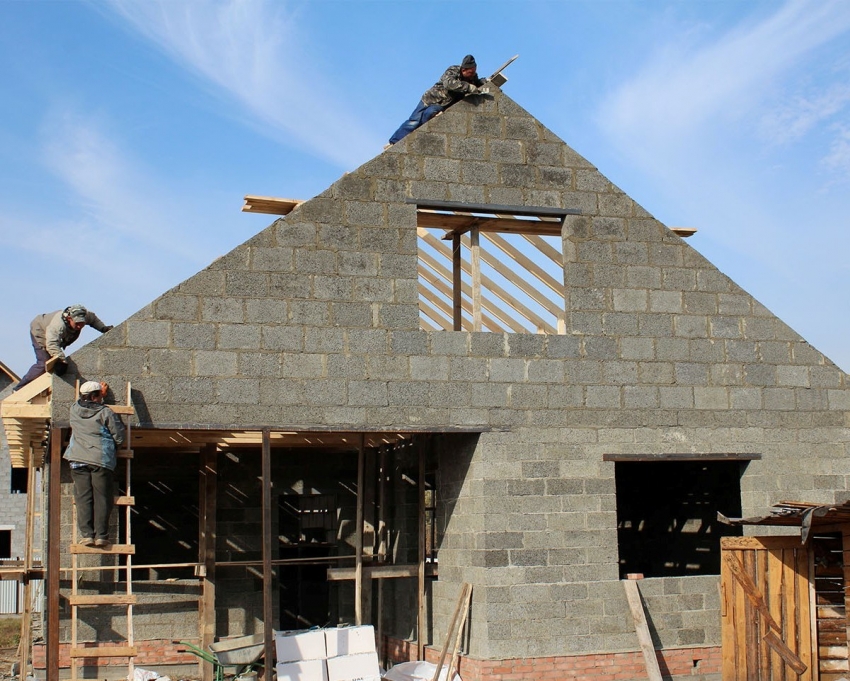
When building a house or a bath from wood concrete blocks, it is worth considering the properties of this material
Arbolite blocks: reviews of home owners, cons
When choosing building materials for the construction of a house, it will be useful to listen to the reviews of home craftsmen who have practical skills in this area. Indeed, unlike the advertising slogans of manufacturing plants, their opinion is objective. In addition, there is another point here, concerning, among other things, wood concrete blocks: reviews of house owners contain information about what mistakes they made when erecting structures from this building material. So, by reading them, you can save not only time, but also money.
The analysis of the shortcomings of wood concrete is easiest to carry out according to the posts on the Internet forums of construction topics. Below are excerpts from some of the posts.
“Working with arbolite is a complete punishment. Dimensional deviation sometimes reaches 20mm! According to the manufacturer, this is consistent with the requirements of some GOST. It took a lot of time to ensure a smooth wall surface. I have to invite builders to finish the work ”.
Anatoly Volkovets, Rostov-on-Don.
“Instead of the promised smell of wood and a healthy microclimate, the house smells of chemistry of some unknown origin. According to the specialists of the construction company, this is all due to the additives included in the arbolite. The question as to whether it will be eliminated after finishing or will simply disappear over time remains open. "
Nikolay Artemenko, Tyumen.
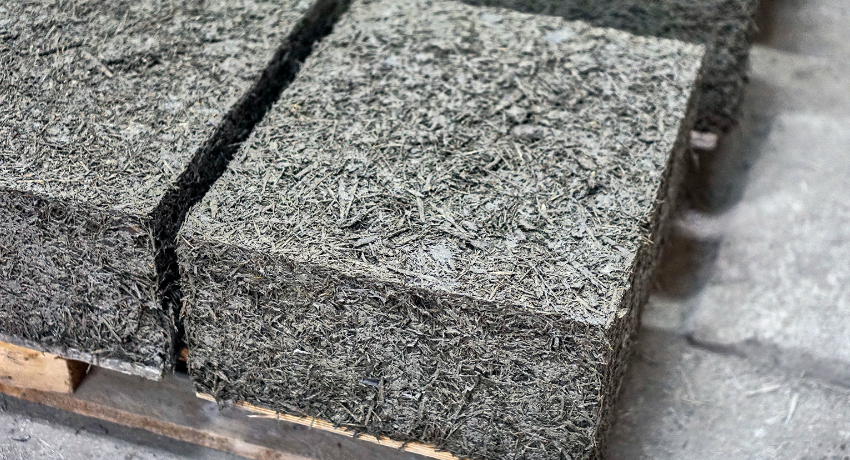
On the Internet, you can find many reviews about the unpleasant smell of wood concrete, which may indicate the low quality of the materials used for the manufacture, so it is important to check the certificates when buying
These two posts are not related to wood concrete products. But ignorance of the peculiarities of using this building material often leads to the appearance of negative reviews. Arbolite blocks, as mentioned above, are of a structural and heat-insulating type. If you do not see the difference between them, you can get a completely different result than the owner expected.
“We have been living in a cold house made of wood concrete for the third year already. Warming was not originally planned. But, apparently, it will not be possible to do without it. For the construction of a solid two-story house with an attic, I used wood concrete construction blocks. I hoped the house would be warm anyway. Most likely, it will be necessary to additionally spend money on its insulation with heat-insulating wood concrete or some other material. "
Konstantin Savushkin, St. Petersburg.
After reviewing the information about the properties of wood concrete blocks, as well as user reviews, you can choose the option that is most suitable in size and cost for building a house or bath.
